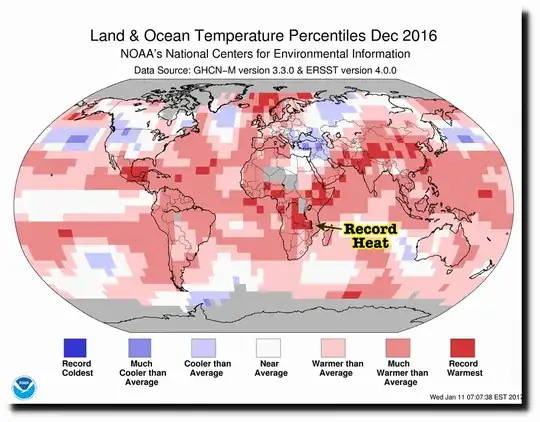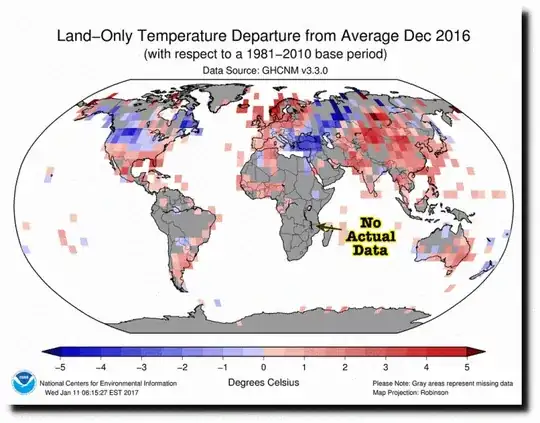tl;dr: The supposedly fake map is composed of multiple sources of data, averaged over larger areas of the Earth and a longer period of its history. The map labelled as "the reality" shows just one of these sources of data, plotted at relatively high resolution, and only where directly comparable data is available from a specific 30-year period.
Both of the maps shown in the article can be downloaded from the NOAA's website on a page of Global Temperature and Precipitation Maps. I have selected from the form December 2016, and four "products":
- the "Global Land Mean Temp Anomaly Map" (labelled on the graph as "Land-Only") is the one being labelled as "the reality"
- the "Global Land & Ocean Temp Percentile Map" matches the "real" graph, but fills in the oceans, and also broad smudges of land
- the "Global Land Temp Percentile Map" (labelled on the graph as "Land & Ocean") is the one being labelled as "fake"
- finally, there is the "Global Z-Score Map"; this has the same coverage as the "fake" map
Maps 2 and 3 are also featured in this report analysing the Dec 2016 data.
On each of these maps, the legend includes two pieces of information which are key to understanding their different coverage.
Firstly, they list their source data:
Secondly, they list the time frame of their comparison: maps 1 and 2 state that they are "with respect to a 1981-2010 base period", while maps 3 and 4 do not. The reason for this, and the base period of the other maps, is explained in this FAQ:
Why do some of the products use different reference periods?
The national maps show temperature anomalies relative to the 1981–2010 base period. This period is used in order to comply with a recommended World Meteorological Organization (WMO) Policy, which suggests using the latest decade for the 30-year average.
For the global-scale averages (global land and ocean, land-only, ocean-only, and hemispheric time series), the reference period is adjusted to the 20th Century average for conceptual simplicity (the period is more familiar to more people, and establishes a longer-term average).
The adjustment does not change the shape of the time series or affect the trends within it.
So we have two very different types of graph:
- a graph comparing a single data set in Dec 2016 against available averages within that dataset for the reference period 1981-2010
- several graphs comparing a combined analysis of two data sets against averages for the period 1901-2000
It would seem an obvious question to ask how an ocean data set can be used to fill in land temperatures. However, the combined data set does more than just overlay the two sets of observations; details of exactly how it is computed are available in these references:
- Smith, T.M., R.W. Reynolds, T.C. Peterson, and J. Lawrimore, 2008: Improvements to NOAA's historical merged land–ocean surface temperatures analysis (1880–2006); Journal of Climate, 21, 2283–2296, doi:10.1175/2007JCLI2100.1
- Vose, R.S., D. Arndt, V.F. Banzon, D.R. Easterling, B. Gleason, B. Huang, E. Kearns, J.H. Lawrimore, M.J. Menne, T.C. Peterson, R.W. Reynolds, T.M. Smith, C.N. Williams, Jr., and D.L. Wuertz, 2012: NOAA's merged land-ocean surface temperature analysis. Bulletin of the American Meteorological Society, 93, 1677–1685, doi:10.1175/BAMS-D-11-00241.1
I have not read the full papers, but I think the key is that the combined data set measures relative rather than absolute temperatures, and is therefore able to combine them across much larger regions. (See also question 7 in the FAQ.) This accounts for the low resolution evident in the graphs which have full coverage. The GHCN-M data has not benefited from this "smoothing", so instead shows smaller patches of data; and it contains absolute temperatures, not deviations from average, so can only be plotted where there is enough to form a meaningful comparison.
Similarly, you might question why a dataset would contain enough data for an average across 1901-2000, but not for 1981-2010. The GHCN-M overview page explains that the dataset was first produced in the 1990s, but composed out of existing historical records. So at the relatively high resolution of the data set, a particular grid point might have values for 1900 to 1980, but none since, while a neighbouring grid point has only recent data. The map of station ages on this page shows very few long-established points in Africa, which would be consistent with the theory that map 1 is missing Africa data because of a lack of consistently placed observations to compare.
To be clear, the "missing data" on map 1 does not mean that there are currently no measuring stations in Central Africa (the location map above shows plenty); it also probably does not mean there weren't any in the period 1981-2010 (I would be very surprised if there weren't). What it probably means is that the measuring stations currently in place are different from those that were in place between 1981 and 2010, meaning that comparisons must be made based on larger analysed areas.

